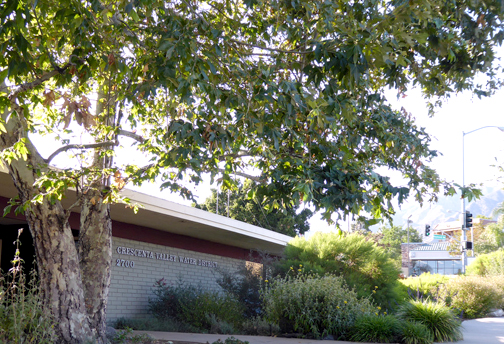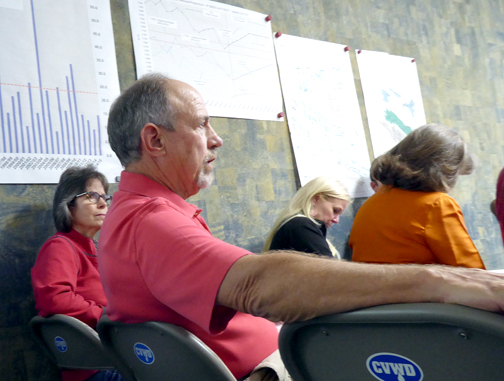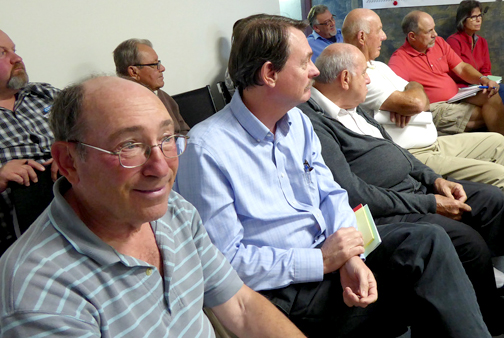
Members of the CVWD board of directors listen to audience members speaking in support of and opposition to a proposed rate increase.
By Julie BUTCHER
Director James Bodnar opened the Crescenta Valley Water District (CVWD) board’s public hearing regarding the rate increase proposed for water rates by welcoming those in attendance, noting “ours is a community water and sewer district.”
“That’s why,” he added, “the key point tonight is to listen.”
District management analyzed cost and usage data and proposed an increase to water rates of approximately $5.46 per month for a typical residence (that is one that uses 8,500 gallons a month). Sewer rates have not increased since 2014 and a rate increase is not proposed.

Board members heard from several of the approximately 22 customers who attended the meeting, provided back-up documentation and answered questions. General Manager Tom Love pledged that answers to all of the questions raised, as well as the full report relied upon for calculating the rate increase, will be answered on the District’s website by close of business on Tuesday, June 20.
Also on June 20, the board will meet at 7 p.m. at the CVWD headquarters at 2700 Foothill Blvd. to specifically deliberate over the rate increase. The board’s meetings are open to the public, and public comment is heard in an informal manner.
Jonas Williams spoke at the meeting and also submitted a seven-page letter dated June 2 raising numerous, detailed questions and urging the board to consider different billing mechanisms to provide relief for owners of larger lots.
“I’ve spent $9,000 installing irrigation equipment. We’ve got six rain barrels. I’ve done everything to save water, and we still fall into the higher tier,” Williams said. He also submitted a petition signed by 10 other district customers.
George Solymar voiced his opposition to the water rate hike.

“I’ve got one brother who lives in Calabasas and has a pool and he pays less than I do. I’ve got another brother who lives in Lakewood and he pays less, too. I’ve been happy to talk engineer-to-engineer to Mr. Tom Love but this doesn’t make sense,” Solymar told the board.
According to the District, revenue from water sales has dropped dramatically in the past three years while the expense for imported, purchased water has increased $630,000 in the past year.
“It is a small, community district, covering only 8,000 customers,” Bodnar said. “On the other hand, we’ve got reserves that few districts maintain. Our pipes are in pretty good shape. But our streets are not straight so our pipes can’t be straight. We’ve got rock and hills. Every drop has to be pumped. Still, our rates are comparable with rates charged by Glendale, Pasadena, and smaller Kinneloa districts.”
The CVWD maintains 88 miles of pipeline, 19 reservoirs, 12 wells and three pumping stations. Some of the facilities are over 70 years old. Unlike similarly situated water districts, the Crescenta Valley Water District funds a Capital Improvement Program (CIP) to plan for infrastructure needs.

Water comes from two sources: local groundwater (the cheapest) and imported water purchased from the Foothill Municipal Water District (FMWD), which purchases its water from the Metropolitan Water District (MWD). That water is more expensive, coming either through the California Aqueduct from the Bay Delta or from the Colorado River.
Crescenta Valley water rates have increased 5.2%, 5.7% and 5.8% each of the three past years, respectively. At the same time, the average rate across California has increased 7%.
Director Mike Claessens addressed the audience.
“We live here, too, and we don’t get a break. We’ve all spent an incredible amount of time grilling staff over costs – my wife is not happy with how much time I spend, in fact. We’re a responsible district. We have reserves. In the event of an earthquake, we anticipate that we could provide 40% of the current usage to our customers immediately. Other districts will look to us in that eventuality.”
“I’m grateful for the diligence we [apply],” Claessens concluded. “Safe, dependable water is one of the reasons we moved here.”
Frank Colcord spoke “in general support of the increase.”
“Water is by far our most precious resource and it is expensive,” Colcord said. “Local water is even more precious. We are privileged to live here; our climate is Mediterranean, and we should take the opportunity to build water reserves while the costs are lowest, to make infrastructure fixes now.”
Following the public hearing, the board indicated it will provide answers to all of the questions raised. The rate increase will be discussed and is expected to be approved at the board meeting set for June 20 at 7 p.m. Comments can be submitted on the District’s website www.cvwd.com.
